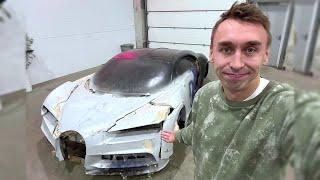Комментарии:

Soooooo... is there a way to get it to lay down solder paste??? :D
Ответить
This is also good for dispersing glue, for glued SMD components. I remember time all SMD components where glued and wave soldered together with THT components. (Ugly memory of SABA TV chasis going trough head). Thanks for nice videos, and for hard work. Best Regards.
Ответить
Great experiment but honestly I'm surprised this machine was not already being marketed for solder paste, adhesive, *ink*, etc.
Ответить
And you've reinvented the V-One dispenser syringe.
Ответить
:O looking at you extruder now i can use it as inspiration to fix my clay extruder , amazing work!, in another note probably you want to add a flat bearing to the gear so you can remove the play and wear.
Ответить
Very interesting video ! Extremely impatient to hear about results for the UV resin idea (instead of carbon, couldn't you put some fine ITO powder or something inside ?), and super hyped about testing that system with common solder paste, this will be transformative (stencils are a pain sometimes) !
Ответить
Doing this with solder paste instead of ink would make PCB assembly so much faster, and less manual. Then include a hot plate as well and boom, soldered PCBs without lifting a finger. Prototyping dream
Ответить
Did you calibrate the ink amount per rotation? This is so cool
Ответить
There's a manufacturing technique called wave soldering where a board is basically dragged across a pool of liquid solder. This works well with through hole components that are all on the same side. However this process can easily be adapted to SMD components by adding a drop of adhesive between the pads of an SMD component. Often it's two tiny drops along the nonconductive edges of the SMD component. Many power boards are made this way where all the through hole components are on one side and all the solder joints and SMD components are on the other side. Anyway, this syringe setup is perfect for this process; it could add the adhesive, then place the components in the adhesive, and then the board would be ready to solder.
Ответить
you could even put a blank pcb plate in, and cnc/laser the lines out. yep one layer. or multiple layers. not trying to pick on you, but.. you only have to do the alignment calibration once. before the jobs. how about silver instead of graphite. yep you can 3d print multi-layer pcbs. well laser the copper traces in between layers.
Ответить
Is that wobbling table interfering with precision?
Ответить
Carbon is too good at absorbing a broad spectrum. Commercial solutions use silver a lot so maybe that's a better option as it might reflect the light deeper into the blob. Loctite has a hole range of conductive silver inks like LOCTITE® ECI 1006 E&C
Ответить
Still think you should try off-the-shelf conductive epoxy.
Ответить
Doesn't that resin also cure when it's heated?
Ответить
Next you need an led and lens to expose traces. Then you need a sponge head to etch it.
Ответить
About the UV resin, did you try different wavelengths UV?
Ответить
Your excitement is contagious, thank you.❤
Ответить
This guy : Builds an exotic pcb manufacturing machine that works on the first tries and is absolutely stocked of his performance.
Me : Tries to print a benchy on my crappy Ender 3 and proceeds to cry and fly it out the window (the printer).

It won't be a surprise but it was quite predictable that the first drops of conductive ink woulnd't go onto the board, it is quite clear that you left a lot of play on the gear connected to the threaded rod, you can see it from the video, you can predict it if you know how you're doing this, you could close the gap a bit, use different materials to avoid friction, or even add a spring probably.
Also if you wanna play around with UV resin you might find some helpfull stuff in proper printing's attempts at an FDM resin printer, it's not the same thing but he was indeed extruding resin with a syringe, you might find helpfull stuff there.
That said I see many people suggest an entirely different route in any case good luck with that!

Have you seen NEMA 6 motors tho? They're basically Jellybeans!
Ответить
i hope it gets an experimental option so we can all use it, would make prototyping so much faster and easier, cause then you can say goodbye to hot plates or baking, and get the prototypes made and tested way faster.
Ответить
Surely there is some clear conductive material from the touch screen or heated glass industry that could be mixed into yhe UV resin rather than the lamp black?
Actually what about chatting to the Positron 3D printer folks, their heated bed is clear!

Yeah, definetely don't mix it with peanut butter from your previous tests or it'll end up in your stomach :D
Ответить
Use metallic micro spheres they have a cool tape that works like that you just need to put them in a glue
Ответить
Nme update:
LumenSNP - squirt n place (system name) or new head only squeeze n paste 😄

That little stepper motor is friggin adorable! 🤩
Ответить
It will be difficult to apply in industrial environment because Cycletime is too high for 1 circuit board.
Ответить
I'm so excited to see it going with solder paste... you could have a reflow plate on the Lumen bed so it automatically reflows after... then maybe even a flying test probe to test the board once soldered, all in the one fixture!!!
Ответить
Algorithm boy here. You could also make a little shape pattern on the back with multiple settings (back and forth on the serynge or air with different pressure). You can calibrate it quickly with it if you have the good tips (in your case, you're the first...).
Python function could generate gcode like for 3d printers pattern and z axis alignement. You can calibrate a lot !

Try adding 12hr setting resin as well as the uv. So that you get a skin set which holds the part with UV then the 12hr setting resing hardens the insides and sets the rest.
Ответить
The python library sounds awesome. Great idea.
Ответить
I can't stop smiling after watching this!
Ответить
0202 electro Hershey kisses made by the lumenPnP
Ответить
First of all, what weird stuff?
If you want your resin to cure, I would suggest to not use carbon... with something reflective like silver maybe even copper you might have a chance. Look into transparent conducting films if it fails.

Sounds nice. What guitar are you using?
Ответить
Awesome, just imagine we are coming in the right direction to create something like a desktop version of the "Essemtec - All-In-One" Machine which can Solder Paste Jet Dispensing and Pick-and-Place... thats the dream!
Ответить
I CAN FEEL YOUR HAPPINES, THIS IS FREAKING AWESOME
Ответить
LEASH MENTIONED
Ответить
There is a paper called "Photo curable resin for 3D printed conductive structures" in the Additive Manufacturing journal. "In this study, researchers used acrylic as the photocurable resin, AgCu flakes, and Ag NP for the metal fillers. They prepared the mixed resin solution/paste by adding 15 wt% of ethylene glycol, 7.428 g of AgCu flakes, 5 wt% single-walled CNTs, and 8 mg of photo-initiator Irgacure-819 into 80 wt% of commercial acrylic resin followed by ultrasonication and magnetic stirring for an hour."
Not sure if these are feasible on your time scale but what you are trying is definitely possible.

Huzzah! That's an awesome result, well done! Yeah, forget conductive ink and get the solder paste application going. That's the golden ticket here :)
Ответить
Have you considered using the same syringe toolhead to apply solder paste?
Ответить
Why are you not doing this with the solder paste please ? makes more sense, but great fun with the ink !
Ответить
Hope it comes a version for solderpaste so no stencil is needed 😉
Ответить
Amazing! If you built it with solder paste could you then have a heated bed to automatically flow the solder paste when it's done?
Ответить
what is the point of this?
Ответить
Have you seen the self soldering PCBs that Carl Bugeja was working on with a built-in heating element layer? It'd be pretty cool to do this with solder paste and have the board solder itself without a reflow oven
Ответить
Has anyone reviewed the V4 Lumen? Thinking about getting one, but I want a tool not a hobby.
Ответить


























